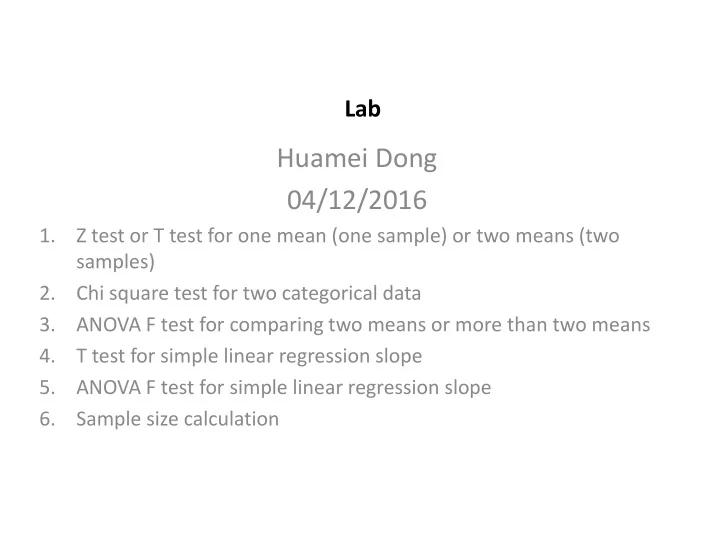

Lab Huamei Dong 04/12/2016 1. Z test or T test for one mean (one sample) or two means (two samples) 2. Chi square test for two categorical data 3. ANOVA F test for comparing two means or more than two means 4. T test for simple linear regression slope 5. ANOVA F test for simple linear regression slope 6. Sample size calculation
1. Z test or T test for comparing two means > birth<-read.table(“births.txt”, as.is=T, header=T, sep=“\t”) > birth_smoker<-subset(birth,smoke=="smoker”) > birth_nonsmoker<-subset(birth,smoke=="nonsmoker”) > hist(birth$weight) > hist(birth_smoker$weight) > hist(birth_nonsmoker$weight)
> t.test(birth$weight~birth$smoke,var.equal=T) Two Sample t-test data: birth$weight by birth$smoke t = 1.5517, df = 148, p-value = 0.1229 alternative hypothesis: true difference in means is not equal to 0 95 percent confidence interval: -0.1095531 0.9105531 sample estimates: mean in group nonsmoker mean in group smoker 7.1795 6.7790
> t.test(birth$weight~birth$smoke,var.equal=F) Welch Two Sample t-test data: birth$weight by birth$smoke t = 1.4967, df = 89.277, p-value = 0.138 alternative hypothesis: true difference in means is not equal to 0 95 percent confidence interval: -0.1311663 0.9321663 sample estimates: mean in group nonsmoker mean in group smoker 7.1795 6.7790
> t.test(birth$weight~birth$smoke) Welch Two Sample t-test data: birth$weight by birth$smoke t = 1.4967, df = 89.277, p-value = 0.138 alternative hypothesis: true difference in means is not equal to 0 95 percent confidence interval: -0.1311663 0.9321663 sample estimates: mean in group nonsmoker mean in group smoker 7.1795 6.7790
> t.test(birth_smoker$weight,birth_nonsmoker$weight,var.equal=T) Two Sample t-test data: birth_smoker$weight and birth_nonsmoker$weight t = -1.5517, df = 148, p-value = 0.1229 alternative hypothesis: true difference in means is not equal to 0 95 percent confidence interval: -0.9105531 0.1095531 sample estimates: mean of x mean of y 6.7790 7.1795
> t.test(birth_smoker$weight,birth_nonsmoker$weight,var.equal=F) Welch Two Sample t-test data: birth_smoker$weight and birth_nonsmoker$weight t = -1.4967, df = 89.277, p-value = 0.138 alternative hypothesis: true difference in means is not equal to 0 95 percent confidence interval: -0.9321663 0.1311663 sample estimates: mean of x mean of y 6.7790 7.1795
> t.test(birth_smoker$weight,birth_nonsmoker$weight) Welch Two Sample t-test data: birth_smoker$weight and birth_nonsmoker$weight t = -1.4967, df = 89.277, p-value = 0.138 alternative hypothesis: true difference in means is not equal to 0 95 percent confidence interval: -0.9321663 0.1311663 sample estimates: mean of x mean of y 6.7790 7.1795 Homework (1) Conduct two sample t test by hand and compare your result with this. Hint: Use r to calculate the sample mean and standard deviation for the weights from smokers and sample mean and standard deviation from nonsmokers. Then use what you have learned in Chapter 5 to find T statistics.
2. ANOVA F test for comparing two or more means > oneway.test(birth$weight~birth$smoke,var.equal=T) One-way analysis of means data: birth$weight and birth$smoke F = 2.4077, num df = 1, denom df = 148, p-value = 0.1229
> oneway.test(birth$weight~birth$smoke,var.equal=F) One-way analysis of means (not assuming equal variances) data: birth$weight and birth$smoke F = 2.2401, num df = 1.000, denom df = 89.277, p-value = 0.138
> oneway.test(birth$weight~birth$smoke) One-way analysis of means (not assuming equal variances) data: birth$weight and birth$smoke F = 2.2401, num df = 1.000, denom df = 89.277, p-value = 0.138
3. Chi square test > table1<-table(birth$sexBaby,birth$smoke) > table1 nonsmoker smoker female 49 19 male 51 31 > chisq.test(table1) Pearson's Chi-squared test with Yates' continuity correction data: table1 X-squared = 1.2139, df = 1, p-value = 0.2706 Homework (2): Conduct the chi-square test by hand and compare your result with this.
4. T test for Simple Linear Regression’s slope > reg1<-lm(birth$weight~birth$smoke) > summary(reg1) Call: lm(formula = birth$weight ~ birth$smoke) Residuals: Min 1Q Median 3Q Max -5.5495 -0.5590 0.2605 0.9505 2.9505 Coefficients: Estimate Std. Error t value Pr(>|t|) (Intercept) 7.1795 0.1490 48.178 <2e-16 *** birth$smokesmoker -0.4005 0.2581 -1.552 0.123 --- Signif. codes: 0 ‘***’ 0.001 ‘**’ 0.01 ‘*’ 0.05 ‘.’ 0.1 ‘ ’ 1 Residual standard error: 1.49 on 148 degrees of freedom Multiple R-squared: 0.01601, Adjusted R-squared: 0.009359 F-statistic: 2.408 on 1 and 148 DF, p-value: 0.1229
Homework(3) : Conduct a T test to test whether the slope for smoker is zero by hand and compare your result with this. (Here response variable is numerical and explanatory is categorical) Hint: For linear regression of numerical response variable against categorical explanatory data, the t test for the slope of simple linear regression is just like two sample t test with two samples having equal variances. So you should use to calculate standard error instead of using . . Then you can calculate T statistics and find p-value. If the simple linear regression is numerical response variable against numerical explanatory variable, then you can used and to calculate statistics (See Example 1 in lecture from April 7).
5. ANOVA F test for simple linear regression’s slope > fit1<-aov(birth$weight~birth$smoke) > summary(fit1) Df Sum Sq Mean Sq F value Pr(>F) birth$smoke 1 5.3 5.347 2.408 0.123 Residuals 148 328.7 2.221
6. Sample size calculation Sample size estimation can be estimated by confidence level, standard error and margin of error. For example, when you would like to sample a group of students in some university and measure their weight. You would like to the population mean weight in the university. Suppose a 95% confidence interval for the true mean is and you want your margin of error to be with in 5%. Then you can estimate your sample size using
Think fun: (1)How can you weigh an elephant in the Zoo? You are provided with a huge wooden box (similar to a boat, but shape is rectangular prism), a big pond, a marker, a small scale, lots of pebbles ) (2) The relation between type I, type II error and crying wolf story.
Recommend
More recommend